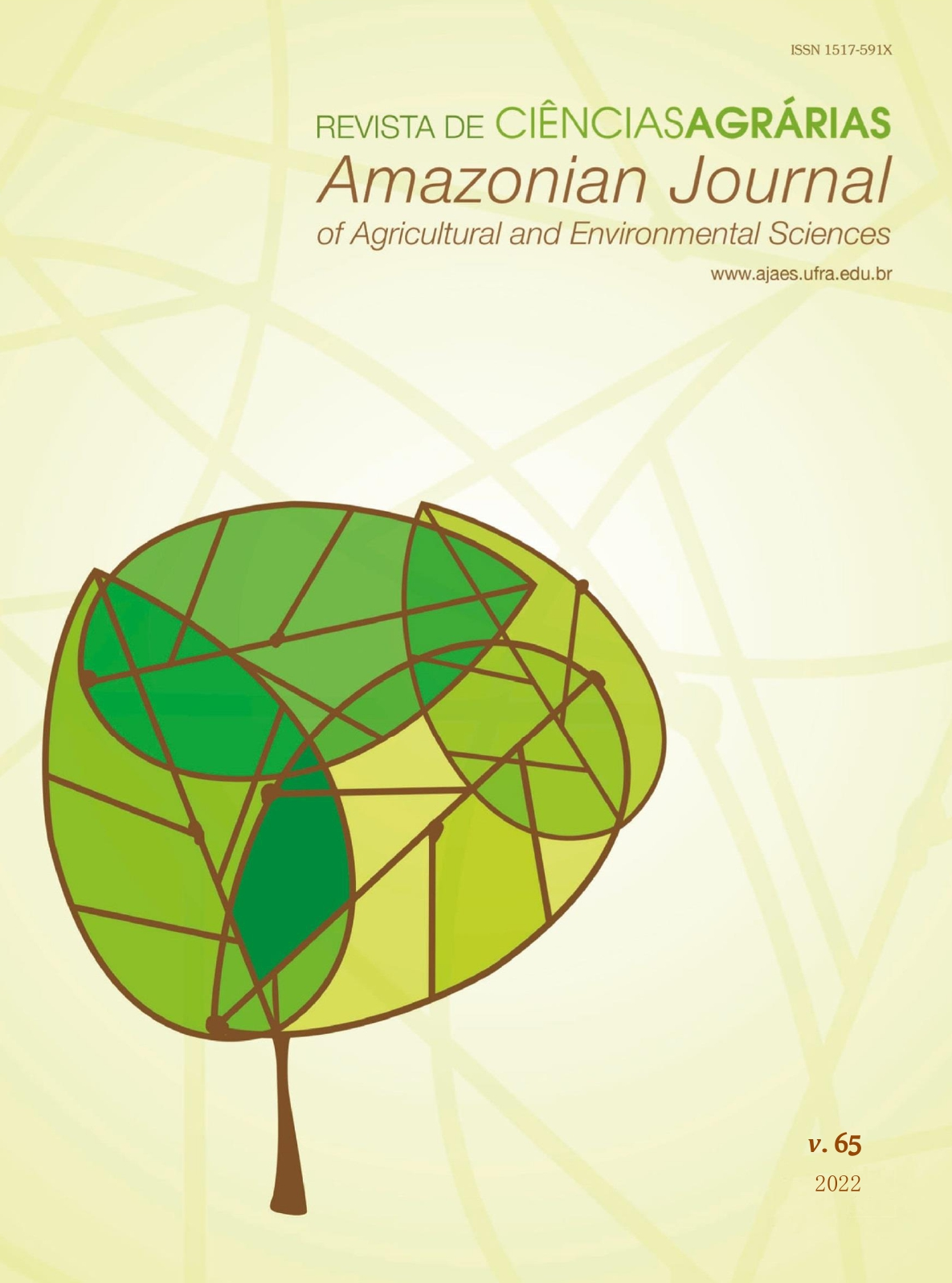Biometric characteristics of varieties of açaí (Euterpe oleracea) fruits
Abstract
Açaí (Euterpe oleracea) is a fruit with economic importance for the North region. However, little is known about the biometric characteristics of the varieties of this species. The study aimed to verify the differences in the biometric characteristics of three varieties of açaí fruits, occurring in the northeast mesoregion of Pará, Eastern Amazon. Ripe fruits of the varieties açaí chumbinho, açaí comum and açaí BRS-Pará were collected and then submitted to measurement of fresh mass, longitudinal and transversal diameter of the fruits; fresh and dry mass and moisture of pulp and seed; and the ratio between pulp and seed. The variety BRS-Pará obtained higher values in the longitudinal and transversal diameter, fresh fruit mass, fresh and dry mass and pulp moisture. However, the chumbinho variety stood out in the percentage of fruit pulp with 36.85%. In the cluster analysis, based on the Euclidean distance, three evident groups were formed for the varieties BRS-Pará, chumbinho and comum. In the analysis of principal components, the group formed by the variety BRS-Pará presented the transversal diameter and fresh mass of the fruit and the seed as the most relevant variables. It is concluded that the variety BRS-Pará was superior in most of the variables. However, the chumbinho variety presented a higher percentage of pulp, which could be attractive for the exploitation of açaí fruits and an advantage for the producer of this variety.
Downloads
References
ALFARO-SOLÍS, J. D. et al. Acrocomia aculeata fruits from three regions in Costa Rica: an assessment of biometric parameters, oil content and oil fatty acid composition to evaluate industrial potential. Agroforestry Systems, v. 94, n. 5, p. 1913–1927, 2020. DOI: 10.1007/s10457-020-00511-8
CARVALHO, J. E. U.; MÜLLER, C. H. Biometria e Rendimento Percentual de Polpa de Frutas Nativas da Amazônia. Comunicado Técnico 139, p. 1–3, 2005.
CEDRIM, P. C. A. S.; BARROS, E. M. A.; DO NASCIMENTO, T. G. Antioxidant properties of acai (Euterpe oleracea) in the metabolic syndrome. Brazilian Journal of Food Technology, v. 21, p. e2018092, 2018. DOI: 10.1590/1981-6723.09217
CORREIA, L. A. DA S. et al. Morphometric descriptors and physiological seed quality for selecting Aspidosperma pyrifolium Mart. matrix trees. Revista Caatinga, v. 32, n. 3, p. 751–759, 2019. DOI: 10.1590/1983-21252019v32n319rc
DE OLIVEIRA, M. DO S. P.; SCHWARTZ, G. Açaí— Euterpe oleracea. In: RODRIGUES, S.; SILVA, E. O; BRITO, E. S. (Eds.) Exotic Fruits. Academic Press, 2018. p. 1–5. DOI: 10.1016/C2014-0-02888-2
FURLANETO, F. D. P. B.; SOARES, A. D. A. V. L.; FURLANETO, L. B. Parâmetros tecnológicos, comerciais e nutracêuticos do açaí (Euterpe oleracea). Revista Internacional de Ciências, v. 10, n. 1, p. 91–107, 29 abr. 2020. DOI: 10.12957/ric.2020.46945
LEGENDRE, P.; LEGENDRE, L. Chapter 7 - Ecological resemblance. In: LEGENDRE, P.; LEGENDRE, L. (Eds.). Developments in Environmental Modelling. 3 ed. Amsterdam: Elsevier, 2012. p. 247–302.
MENDES, G. G. C. et al. Genetic divergence of native palms of Oenocarpus distichus considering biometric fruit variables. Scientific Reports, v. 9, n. 1, p. 1–9, 2019. DOI: 10.1038/s41598-019-41507-4
OLIVEIRA, M. DO S. P.; FARIA NETO, J. T. Cultivar BRS-Pará: Açaizeiro para Produção de Frutos em Terra Firme. Comunicado Técnico 114, p. 1–3, dez. 2004.
OLIVEIRA, M. DO S. P.; FARIAS NETO, J. T.; PENA, R. DA S. Açaí: técnicas de cultivo e processamento. Fortaleza: Instituto Frutal, 2007.
OLIVEIRA, M. S. P. et al. Euterpe oleracea e E. precatoria. In: L., C.; CAMILLO, J.; VIEIRA, I. C. G. (Eds.). Espécies nativas da flora brasileira de valor econômico atual ou potencial: plantas para o futuro: região norte. Brasília, DF: MMA, 2022. p. 303–323.
R development core team. R: A language and enviroment for statistical computing. Vienna: R Foundation for Statistical Computing. Disponível em:
REMIGANTE, A. et al. Açaì (Euterpe oleracea) Extract Protects Human Erythrocytes from Age-Related Oxidative Stress. Cells, v. 11, n. 15, p. 2391, 3 ago. 2022. DOI: 10.3390/cells11152391
SILVA, A. DA C. D. et al. Tamanho da semente e substratos na produção de mudas de açaí. Advances in Forestry Science, v. 4, n. 4, p. 151–156, 2017. DOI: 10.34062/afs.v4i4.4590
STERZELECKI, F. C. et al. Açai palm, Euterpe oleracea, seed for aquaponic media and seedling production. Aquacultural Engineering, v. 98, 1 ago. 2022. DOI: 10.1016/j.aquaeng.2022.102270
YUYAMA, L. K. O. et al. Caracterização físico-química do suco de açaí de Euterpe precatoria Mart. oriundo de diferentes ecossistemas amazônicos. Acta Amazonica, v. 41, n. 4, p. 545–552, 2011. DOI: 10.1590/S0044-59672011000400011
Copyright (c) 2022 Gabriela Cristina Nascimento Assunção, Thaiana De Jesus Vieira De Assis, Cássio Rafael Costa dos Santos, Marilia Shibata

This work is licensed under a Creative Commons Attribution-NonCommercial 4.0 International License.
Authors retain copyright and grant the Journal the right to the first publication. Authors are encouraged to and may self-archive a created version of their article in their institutional repository, or as a book chapter, as long as acknowledgement is given to the original source of publication. As the Journal provides open access to its publications, articles may not be used for commercial purposes. The contents published are the sole and exclusive responsibility of their authors; however, the publishers can make textual adjustments, adaptation to publishing standards and adjustments of spelling and grammar, to maintain the standard patterns of the language and the journal. Failure to comply with this commitment will submit the offenders to sanctions and penalties under the Brazilian legislation (Law of Copyright Protection; nº 9,610; 19 February 1998).


.jpg)









